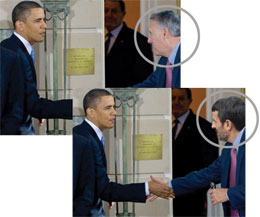Remember When?
 The online magazine Slate has a largely political audience, so last May when it showed readers a picture of Barack Obama shaking hands with Mahmoud Ahmadinejad at a United Nations conference, many were familiar with the momentous occasion. In the image, a straight-faced and upright Obama receives the hand of the Iranian President, who leans into the gesture wearing a slight grin. About half of Slate’s readers recalled that the handshake had taken place, and roughly a quarter remembered watching the event through various media coverage.
The online magazine Slate has a largely political audience, so last May when it showed readers a picture of Barack Obama shaking hands with Mahmoud Ahmadinejad at a United Nations conference, many were familiar with the momentous occasion. In the image, a straight-faced and upright Obama receives the hand of the Iranian President, who leans into the gesture wearing a slight grin. About half of Slate’s readers recalled that the handshake had taken place, and roughly a quarter remembered watching the event through various media coverage.
Those are impressive figures, not because they demonstrate a high degree of political awareness on the part of Slate’s readership. Rather, they confirm years of psychological research showing that false memories can be implanted successfully in about 30 percent of people. In reality, the handshake between Obama and Ahmadinejad never occurred; Slate doctored the photo and presented it to readers as part of an online experiment designed to illustrate the fallibility of memory. The results were revealed in a seven-part series that described the life and work of memory scientist Elizabeth Loftus.
Readers who first found the study last spring — it appeared several days before the Loftus series was published — didn’t know they were getting involved in a memory experiment. Those who participated thought they were giving their impressions of important political moments from the previous decade. With this understanding in mind, readers viewed images of four moments and marked whether or not they remembered seeing the event take place. They could also recall their feelings about the incident at the time it had occurred.
More than 5,000 readers participated in the experiment during the first three days. All participants saw images of the same three real events as well as a fourth, randomly selected false moment, whose accompanying image and caption had been fabricated by Slate. Overall, readers recalled the true events more often than the manipulated ones, but the altered images did create false memories in the minds of many test participants. For instance, 26 percent of readers said they recalled seeing the Obama-Ahmadinejad handshake.
Slate found similar results for the other falsified events: 15 percent of participants recalled seeing Joe Lieberman vote to convict the impeached Bill Clinton; another 15 percent recalled watching George W. Bush and pitcher Roger Clemens relax at Bush’s ranch during Hurricane Katrina; 36 percent believed they had seen a campaign ad about Reverend Jeremiah Wright aired by Hillary Clinton; and 42 percent remembered watching Dick Cheney rebuke John Edwards for mentioning Cheney’s lesbian daughter during a vice-presidential debate.
Many readers described their memories of the event in vivid, certain terms. “The Chicago Trib had a big picture of this meeting,” one participant wrote about the Obama-Ahmadinejad image. “Reminded me of JFK with the Russians. Naive,” wrote another. When Slate combined the number of participants who recalled seeing the false event with those who hadn’t seen it but remembered that it had happened, each of these false-memory rates jumped even higher.
“Here are politically savvy readers — the ones inclined to be reading Slate and want to participate — and they still got these false-memory rates that ranged from 15 percent to 40 percent,” says Loftus.
Loftus had no personal role in structuring the Slate experiment, but its design echoed that of a study published in a 2007 issue of Applied Cognitive Psychology, in which Loftus and collaborators altered images of protests in Tiananmen Square and then asked people to recall the events. William Saletan, who conceived and wrote the Loftus series, believed her work would resonate more powerfully with readers who had experienced a test similar to those run in Loftus’s lab at the University of California-Irvine.
“You’re not just a reader learning about other people’s malleable memories,” says Saletan. “You get to experience that problem firsthand, as a subject in an experiment.”
Loftus was impressed by the number of subjects recruited in such a short time. (“Don’t tell NSF,” she said.) But while Slate’s sample size was enviable, running the online experiment wasn’t without its own methodological challenges. Initially Saletan worried the test would be corrupted by participants who simultaneously searched for the political moments in another Internet browser. Saletan and Chris Wilson, who programmed the data-recording system, also struggled with ways to prevent people from taking the test twice. But if some participants did repeat the experiment, then Slate’s results are even more impressive, says Loftus; after all, second-timers would correct their mistakes, so the data would “underestimate the true rate of false memory.”
“I was so pleased to see the results,” she says. “It shows you don’t have to have a PhD in psychology to do an interesting experiment.”




APS regularly opens certain online articles for discussion on our website. Effective February 2021, you must be a logged-in APS member to post comments. By posting a comment, you agree to our Community Guidelines and the display of your profile information, including your name and affiliation. Any opinions, findings, conclusions, or recommendations present in article comments are those of the writers and do not necessarily reflect the views of APS or the article’s author. For more information, please see our Community Guidelines.
Please login with your APS account to comment.